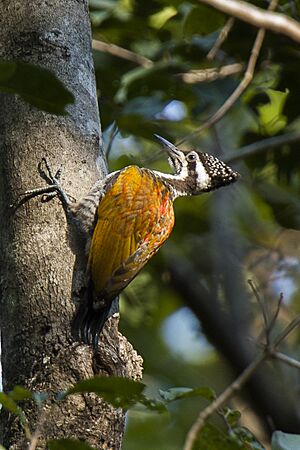Greater flameback facts for kids
Quick facts for kids Greater flameback |
|
|---|---|
 |
|
| Male in Kaeng Krachan National Park, Thailand | |
| Conservation status | |
| Scientific classification | |
| Genus: |
Chrysocolaptes
|
| Species: |
guttacristatus
|
The greater flameback (Chrysocolaptes guttacristatus) is a type of woodpecker that lives in many parts of Asia. You might also hear it called the greater goldenback or large golden-backed woodpecker. These colorful birds are found across the northern Indian subcontinent, stretching east to southern China, the Malay Peninsula, and islands like Sumatra, western and central Java, and northeast Borneo.
Contents
Different Kinds of Greater Flamebacks
Scientists sometimes group animals together based on how closely related they are. They have suggested that the greater flameback might actually be several different species. This means what we call the greater flameback today could be split into these separate types:
- The main greater flameback (C. guttacristatus)
- The Crimson-backed flameback (C. stricklandi) from Sri Lanka
- The Javan flameback (C. strictus) found in eastern Java, Bali, and the Kangean Islands
- The Luzon flameback (C. haematribon) from Luzon and nearby islands in the northern Philippines
- The Yellow-faced flameback (C. xanthocephalus) from islands like Negros and Panay in the Philippines
- The Buff-spotted flameback (C. lucidus) from islands like Bohol and Mindanao in the Philippines
- The Red-headed flameback (C. erythrocephalus) from Palawan and other islands in the Philippines
- The Malabar flameback (C. socialis) from southwestern India
What Greater Flamebacks Look Like
The greater flameback is a large woodpecker, growing to about 33 centimeters (about 13 inches) long. It has the typical shape of a woodpecker, with a tall crest on its head and a long neck. Their colors can change a lot depending on where they live.
They always have golden-yellow to dark brown backs and wings without any spots. Their rump (the area above the tail) is red, and their tail is black. Their undersides are usually white with dark patterns like zigzags, stripes, or bands. Their head can be whitish with black marks, or it can be yellow, brown, or red.
Their beak is straight and pointed, and it's longer than their head. Their legs are lead-grey and have special feet called zygodactyl feet. This means two toes point forward and two point backward, which helps them grip tree trunks. Their eyes are usually whitish to yellow.
Males and Females
Adult male greater flamebacks always have a bright red crown (the top of their head). Female flamebacks have different crown colors depending on their specific type. Their crowns might be black with white spots, yellow, or brown with lighter dots. Young birds look similar to the females but have duller colors and brown eyes.
How to Tell Them Apart from Similar Birds
Some greater flameback types with white and black heads look a bit like other woodpeckers called Dinopium flamebacks. However, they are not very closely related.
You can often tell them apart by looking at their "mustache" stripes. On greater flamebacks, these dark stripes are broken up by white, making them less noticeable from far away. Also, most greater flamebacks have a white back of the neck, while Dinopium species have a black neck and upper back. Dinopium flamebacks are also smaller and have shorter beaks.
How Greater Flamebacks Live
This flameback lives in different kinds of open forests. You can find them in the foothills of the Himalayas or in the Western Ghats. They also live in mangrove forests, which are special forests that grow in salty water.
Like other woodpeckers, the greater flameback uses its strong beak to dig for food inside trees. Their special zygodactyl feet and stiff tail help them hold onto tree trunks while they work. They have a long tongue that can shoot out to grab arthropods (like insects) that live inside the wood. While they mostly eat small bugs, greater flamebacks also drink nectar from flowers.
When it's time to have babies, they make their nests in holes inside trees. The female usually lays three or four white eggs.
Conservation Status
The greater flameback is found in many places and is quite common in some areas. Because of this, it is listed as "least concern" on the IUCN Red List. This means scientists are not worried about it becoming endangered right now.



